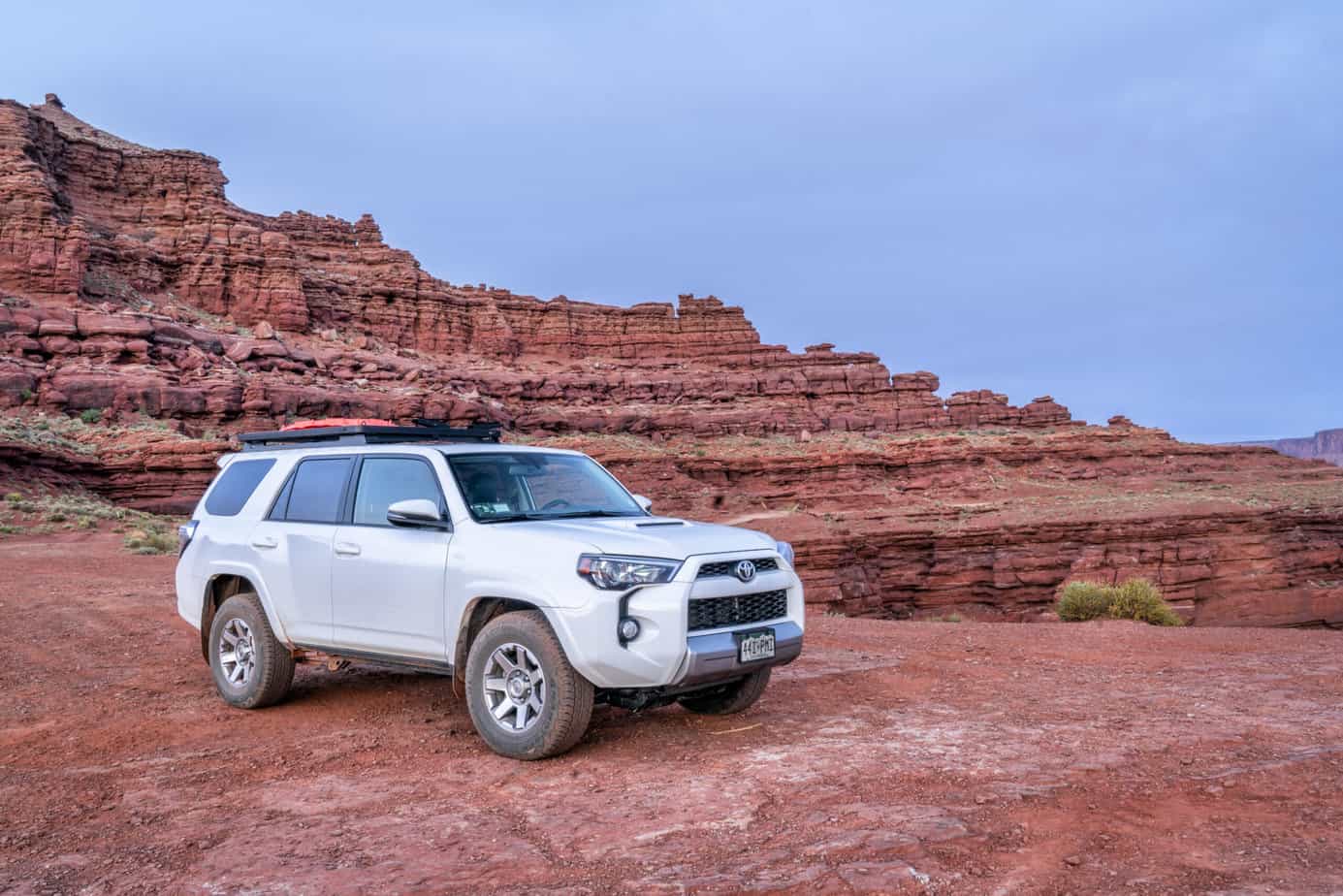Selecting the perfect overlanding vehicle can be a daunting task, especially when considering budget constraints. Overlanding is an adventure that involves exploration while driving an off-road capable vehicle, typically across great distances. The choice of vehicle dramatically affects both the experience and the ability to handle various terrains and weather conditions.
To choose the best overlanding vehicle within a budget, it is vital to assess factors such as durability, fuel economy, suspension, aftermarket accessory options, and off-road capability. Conducting thorough research and understanding individual needs will lead to selecting a vehicle that provides the desired balance between performance, reliability, and affordability.
Finding the right vehicle often involves a mix of personal preferences, practical requirements, and financial considerations. Thus, it’s essential to consider not only the initial purchase price but also the long-term costs associated with maintenance, fuel, and modifications. Weighing these factors will ensure a rewarding and enjoyable overlanding journey.
Determining Your Overlanding Needs and Budget
When choosing the best overlanding vehicle for your budget, it’s essential to assess your needs and financial constraints. Overlanding is about adventure, comfort, and travel, so it’s crucial to take these factors into account before making a decision.
First, consider the primary purpose of your overlanding trips. Will you be tackling tough terrains or sticking to more established routes? Your choice of vehicle should reflect the challenges you expect to face. A standard 4×4 SUV such as a Jeep Wrangler or Toyota 4Runner will handle most off-road situations, while a pickup truck with a camper may be suitable for those who need more space and comfort.
Your budget will significantly influence your choice of vehicle. Assess how much you are willing to invest in your overlanding experience. Keep in mind that your budget should cover not only the vehicle purchase but also upgrades, maintenance, and travel-related expenses. Look for vehicles within your price range, and then assess their features, capabilities, and reputation in the overlanding community.
Comfort is another crucial factor to consider. Will you be sleeping inside your vehicle, or do you plan to use a rooftop tent? If you intend to spend extended periods on the road, prioritize vehicles with ample storage space and roomy interiors. Similarly, factor in the number of passengers you will have and their comfort needs during the journey.
Lastly, consider the availability and cost of aftermarket modifications and accessories that you may require to enhance your overlanding experience. Some vehicles have a more extensive range of aftermarket options, while others may be limited in terms of customization possibilities.
By taking the time to determine your overlanding needs and budget, you can confidently select a vehicle that will serve as a reliable and fitting companion throughout your off-pavement adventures.
Vehicle Type and Off-Roading Capability
When choosing the best overlanding vehicle for your budget, it’s essential to consider the type of vehicle and its off-roading capabilities. Different vehicles are suited for various off-road terrains and conditions, so it’s important to find a vehicle that meets your specific needs.
SUVs
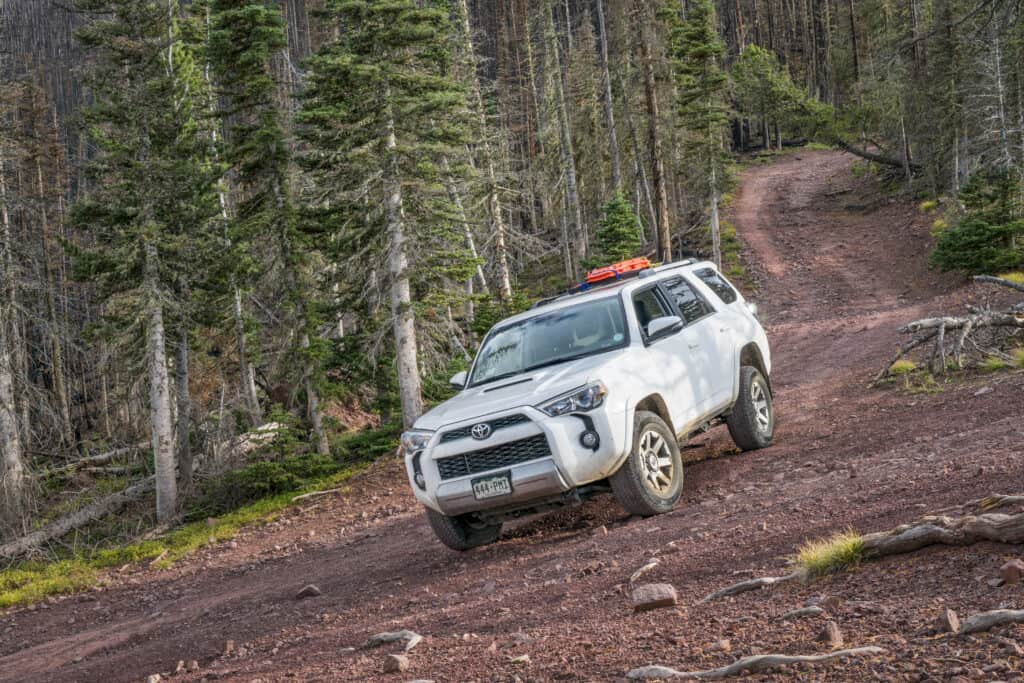
SUVs are a popular choice for overlanding due to their versatility on different terrains. They come in various sizes, with 4WD options, and numerous models offer excellent off-roading capabilities. Notable SUVs for overlanding include the Toyota 4Runner and Lexus GX.
Pickup Trucks
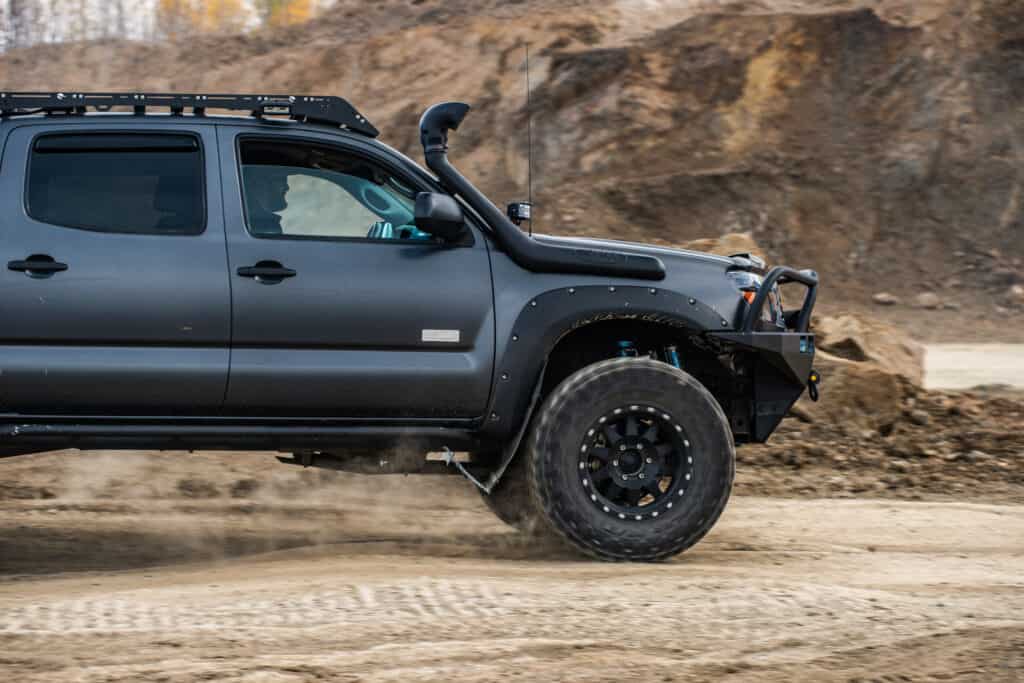
Pickup trucks also make excellent overlanding vehicles, especially for those looking for additional payload capacity. Leading pickup trucks for overlanding include the Toyota Tacoma and the RAM Cummins 2500/3500.
Vans
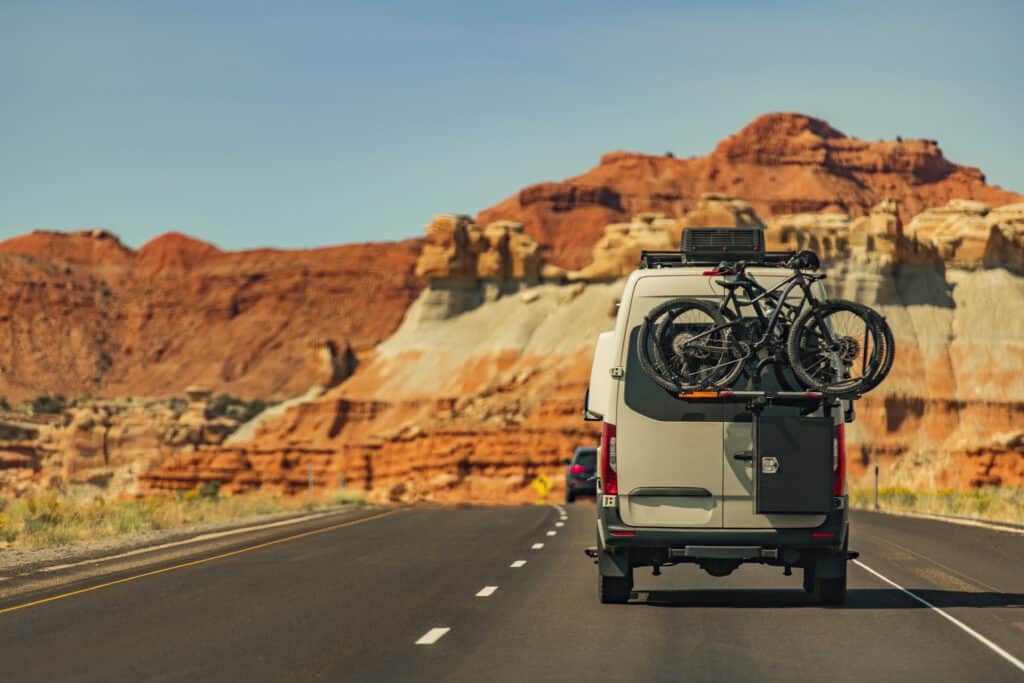
Vans, whether converted campervans or 4WD models like the Mercedes Sprinter, offer ample living and storage space, making them also suitable candidates for extended journeys. However, off-roading capabilities might not be as high as with specialized SUVs or pickup trucks.
Jeep
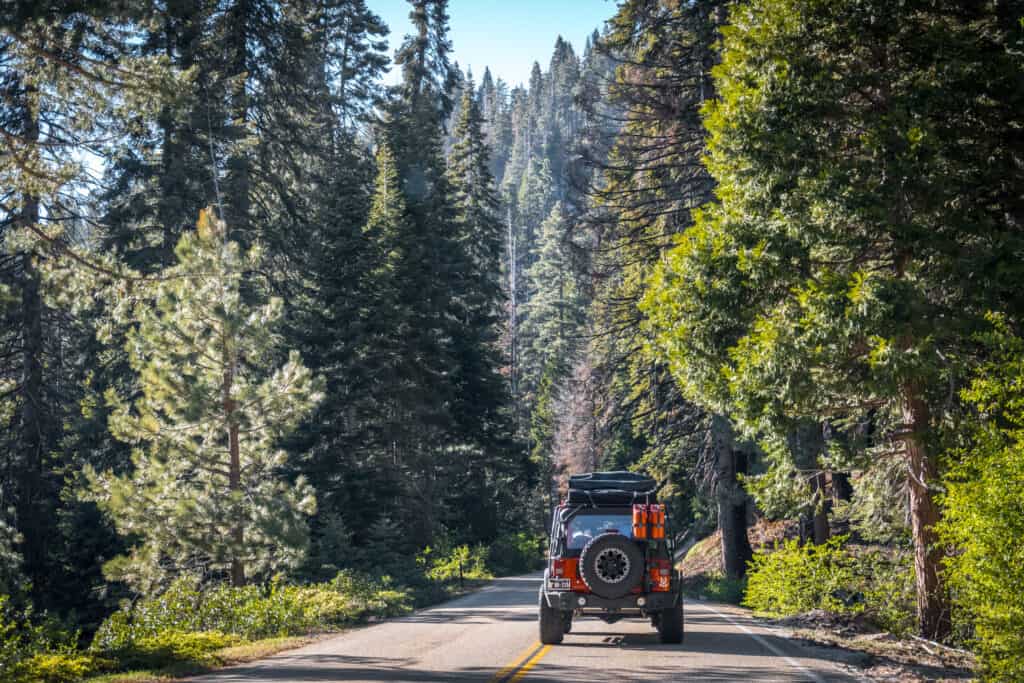
Jeep models are known for their robust off-road performance, particularly the Jeep Wrangler Rubicon and Jeep Gladiator. They are an excellent choice for off-roading enthusiasts who prioritize capability on more challenging terrains.
Toyotas
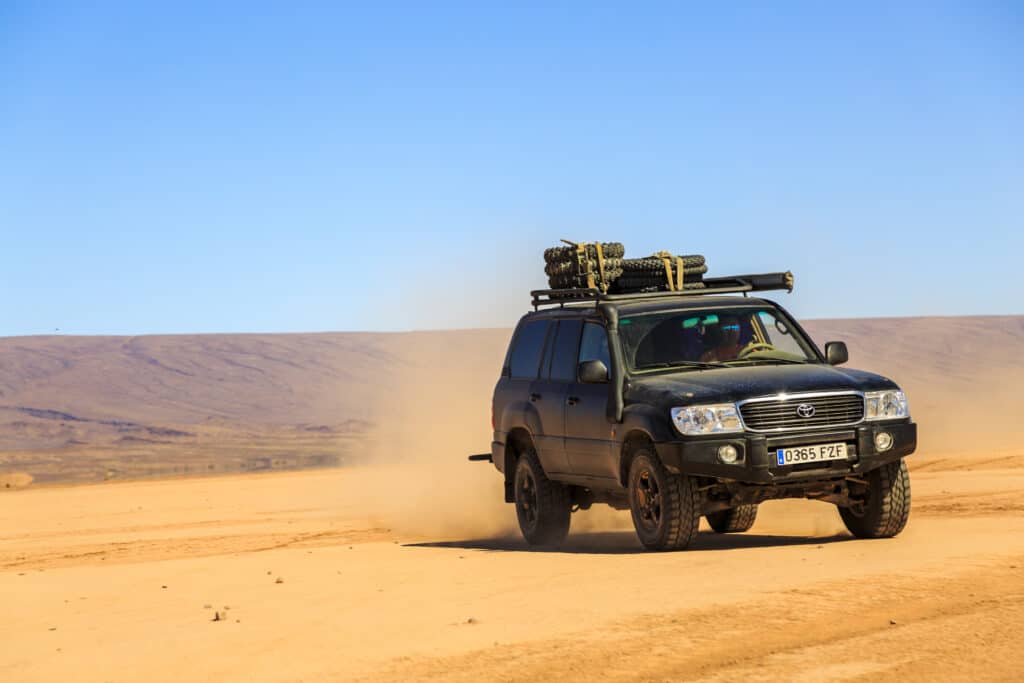
Toyotas have a longstanding reputation for reliability and durability in the overlanding community. Models like the Toyota Land Cruiser and the previously mentioned 4Runner and Tacoma are fan favorites for their combination of performance and dependability.
It’s crucial to evaluate the primary terrain you’ll encounter while overlanding and the level of off-roading capability you require. Each vehicle type offers unique advantages, so consider these factors while keeping your budget in mind.
Popular Overlanding Vehicles
When it comes to choosing the best overlanding vehicle for your budget, several tried-and-true models stand out for their versatility, durability, and off-road capabilities. From popular brands like Toyota and Jeep to more unique options like the Land Rover Defender, there’s an overlanding vehicle for nearly every preference and budget.
Toyota 4Runner is a fan favorite in the overlanding community due to its combination of reliability, off-road prowess, and comfort. With excellent ground clearance and a strong aftermarket support system, the 4Runner is an ideal choice for any journey.
Another popular Toyota choice is the Land Cruiser, known for its ruggedness and long lifespan. While the Land Cruiser may be a pricier option, its durability and ability to tackle nearly any terrain make it a considerable investment for an overlanding vehicle.
The Toyota Tacoma is well-suited for overlanding adventures as well. This mid-sized pickup truck offers great off-road capabilities, a customizable bed, and plenty of aftermarket support to tailor the vehicle to your specific needs.
In the world of Jeeps, the Wrangler is a classic choice for overlanding enthusiasts. Its robust design, easily removable doors and roof, and countless aftermarket parts make the Wrangler a highly customizable option for those looking to take their overlanding experience to the next level.
The Jeep Gladiator, similar to the Wrangler in design, is a unique hybrid of a pickup truck and SUV, making it an ideal choice for adventurers wanting the best of both worlds. It offers excellent towing capacity, decent payload, and a comfortable living space for an extended journey.
Another Jeep option worth considering is the Cherokee XJ. With its modest price point, off-road capabilities, and aftermarket potential, the Cherokee XJ is an excellent beginner-friendly overlanding vehicle.
The Mitsubishi Montero is another reliable yet relatively affordable off-road vehicle worth considering, especially for those on a tighter budget. With a spacious interior and solid off-road performance, the Montero makes for a dependable overlanding companion.
The Land Rover Defender, often admired for its rugged aesthetic and off-road capabilities, is another great overlanding vehicle option. While its price tag might be higher, investing in a Defender promises an unparalleled off-road experience and a vehicle that’s sure to stand the test of time.
For a more budget-friendly 4×4 option, the Nissan Xterra is a solid choice with its reliability, off-road potential, and spacious interior. It’s also a great vehicle for customization, allowing you to personalize it to best suit your overlanding needs.
Lastly, the Subaru Outback offers a more toned-down option for those seeking a more fuel-efficient, daily driver-friendly vehicle that can still handle itself off-road. With all-wheel drive and a lower base price than many competitors, the Outback might be the perfect option for budget-conscious overlanders.
In conclusion, no matter your budget or specific needs, there is a wide variety of popular overlanding vehicles to consider. Confidently make your decision with the knowledge that there’s an option out there that will be well-suited for your next adventure.
Vehicle Features and Performance
When choosing the best overlanding vehicle for your budget, it’s essential to consider several key features and performance characteristics. These factors will significantly impact your overlanding experience and ensure you get the most out of your investment.
Clearance is an important aspect you don’t want to overlook, as it determines how well a vehicle can navigate various terrain without damage or getting stuck. Look for a vehicle with a high ground clearance and adjustable suspension, which allows you to easily traverse over rocks, water crossings, and uneven surfaces.
Power and torque are also vital characteristics, as they affect a vehicle’s ability to navigate challenging terrains and steep inclines. Aim for a vehicle with a strong engine that delivers adequate horsepower and torque without compromising on fuel economy. Gasoline engines can offer higher power outputs, but diesel engines generally provide better low-end torque and fuel efficiency.
Size and footprint play a significant role in an overlanding vehicle’s maneuverability and compatibility with different travel scenarios. A more compact vehicle is easier to steer in tight spots and goes through narrow trails, while a larger one might offer increased comfort and storage options.
The make and model of the vehicle can influence its customization options and aftermarket support. Well-established makes typically have a wide array of available modifications, such as solid axles, locking differentials, and custom suspensions, which can enhance the overlanding capabilities of your vehicle.
Fuel economy should not be overlooked, as it can impact your overall travel costs and determine how far you can go between refueling stops. Choose a vehicle with good gas mileage while maintaining sufficient power output.
Reliability is another critical factor, as you don’t want to deal with breakdowns and costly repairs while traveling off the beaten path. Consider vehicles known for their durability and dependability to ensure a smooth overlanding experience.
Lastly, take into account features like advanced suspension systems, adequate crawl control, and locking differentials to improve your vehicle’s off-road performance and manage challenging terrain conditions.
By evaluating these features and performance factors, you can confidently choose the best overlanding vehicle to suit your budget and travel preferences.
Comfort, Space, and Seating Arrangements
When choosing the best overlanding vehicle for your budget, it’s essential to consider comfort, space, and seating arrangements. The vehicle should offer a balance of interior space, cargo capacity, and seating options to accommodate both passengers and gear.
SUVs are popular choices for overlanding due to their ample interior space and versatile seating configurations. Many offer foldable or removable seats, allowing you to adjust the passenger and cargo capacity to meet your needs. Examples of such SUVs include the Toyota 4Runner and Jeep Wrangler. These models are known for their rugged design, standard 4-wheel-drive, and spacious interiors that can comfortably accommodate both passengers and equipment.
Cargo space is essential for stowing gear, supplies, and any small appliances you may need during your overlanding adventure. Look for vehicles with tall, boxy cargo areas and easy-to-clean plastic or rubber flooring. Tie-down areas and storage compartments can help make organization and packing more manageable.
Weight capacity is another factor to consider as the vehicle must be able to handle the added weight of passengers, gear, and any modifications needed for off-road performance. Overloading your vehicle can lead to decreased performance and possible damage to the suspension, tires, and other components.
In addition to SUVs, pickup trucks are also a viable option for overlanding. Models like the Ford F150 or Jeep Gladiator provide a unique mix of cargo capacity, off-road capabilities, and versatile seating arrangements. Pickup truck beds can also be outfitted with camper shells or rooftop tents to create sleeping quarters or additional storage.
In summary, consider comfort, space, and seating arrangements while choosing an overlanding vehicle within your budget. Whether you opt for an SUV or pickup truck, make sure it has the interior space, cargo capacity, and weight capacity needed to accommodate your passengers and gear for successful off-roading adventures.
Vehicle Upgrades and Modifications
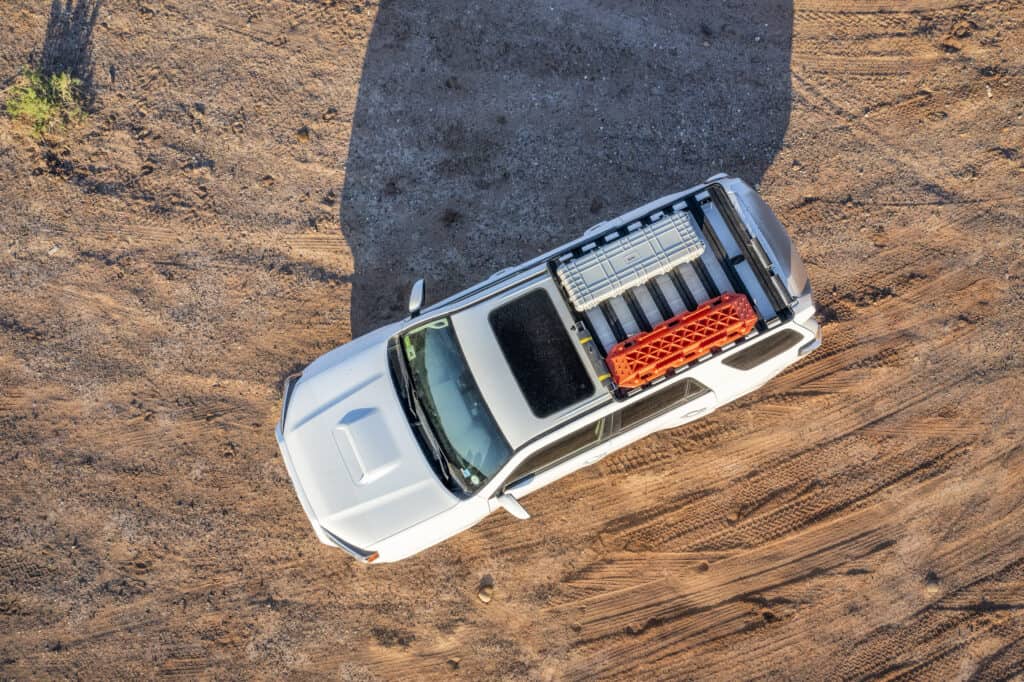
When choosing the best overlanding vehicle for your budget, it’s essential to consider potential upgrades and modifications. These enhancements will improve your vehicle’s performance and functionality, making off-roading adventures more enjoyable and efficient.
It’s crucial to prioritize mods based on your needs and budget. Key factors to consider for vehicle upgrades are features, off-roading capabilities, maintenance, storage, payload, towing capacity, and aftermarket parts availability.
Off-roading capabilities are usually the primary concern for overlanders. Upgrading to off-road tires can significantly improve traction and durability on rough terrain. A V8 engine offers more power and torque, allowing vehicles like the Lexus GX to tackle challenging off-road situations. Similarly, recovery gear is essential for when you find yourself in a sticky situation – it’s vital to know how to use it and make it a part of your rig.
After ensuring your vehicle’s off-road capabilities, consider modifications for storage and payload capacity. Space for essential equipment, camping gear, and personal belongings during long overlanding trips can be a challenge. Investing in proper storage solutions like roof racks and cargo organizers will efficiently utilize the vehicle’s limited space.
Upgrading your vehicle’s towing capacity might be a priority for adventurers hauling campers or trailers along the way. This becomes critical if you’re planning on bringing additional equipment or transportation options and should be factored into the overall vehicle modification process.
Lastly, when investing in an overlanding vehicle, consider the availability and pricing of aftermarket parts. Popular models with readily accessible aftermarket parts tend to be more budget-friendly in the long run. Additionally, they make repairs and modifications more manageable and cost-effective.
Remember that with vehicle upgrades and modifications, a balance between necessity and budget is crucial. Prioritize the enhancements that provide the most benefit for your overlanding experience, and enjoy the journey!
Safety and Durability
When choosing the best overlanding vehicle for your budget, safety and durability should be top priorities. A reliable vehicle should be built to withstand harsh off-road conditions and keep its passengers safe throughout the journey.
One popular and versatile choice for overlanding is the Land Cruiser. Known for its durability and off-road capabilities, the Land Cruiser has a well-earned reputation for being a safe and reliable choice for overlanding enthusiasts. Its sturdy construction, proven drivetrain, and reputation for reliability make it a strong contender when considering safety and durability.
A key factor to consider when evaluating a vehicle’s safety is its departure angle. The departure angle is the angle between the ground and a line drawn from the lowest point of the rear bumper to the rear tire contact point. The greater the departure angle, the less likely the vehicle is to scrape or damage the rear bumper while navigating steep inclines or uneven terrain. A good departure angle allows for more off-road versatility and ultimately contributes to the overall safety of the vehicle.
Durability is another essential factor to consider for overlanding vehicles. A durable vehicle will withstand the challenges of off-road conditions and require minimal repairs during extended trips. To determine the durability of a vehicle, take into account its construction materials, craftsmanship, and history of reliability in off-road situations. Vehicles with a history of minimal issues and a reputation for handling rough terrain without major repairs are prime candidates for overlanding.
In summary, prioritizing safety and durability is paramount when searching for the ideal overlanding vehicle within your budget. The Land Cruiser is an excellent example of a vehicle that offers versatility and has a proven track record in these realms. By considering factors such as departure angle and overall durability, you’ll be well on your way to selecting the perfect overlanding vehicle for your adventures.
Overland Trip Preparation
When preparing for an overland trip, it’s crucial to choose a vehicle that can tackle various terrains and weather conditions while providing comfort and function for camping. A well-prepared overlanding vehicle has a mix of capability, traction, and suitable angles for handling obstacles like mud, snow, ice, sand, rocks, and water crossings.
Capability is essential for an overlanding vehicle, ensuring that it can traverse off-road routes with ease. A 4×4 SUV like the Jeep Wrangler or Toyota Land Cruiser is a popular choice for its combination of power, performance, and adaptability. Payload, fuel economy, and power output are other factors to consider when selecting the perfect overlanding rig.
Traction is crucial in handling obstacles such as slippery or loose surfaces, and steep inclines. Sufficient ground clearance, appropriate tires, and suspension are essential for tackling challenging terrains safely. Approach, breakover, and departure angles should also be considered, as they determine the vehicle’s ability to navigate steep terrain without scraping or damaging the undercarriage.
When traveling in remote regions, water crossings are often unavoidable. Enabling a vehicle to traverse through water safely typically requires a combination of ground clearance, water-resistant components, and possibly a snorkel system. Depending on the type of vehicle chosen for overlanding, towing capacity can also become a factor when bringing along additional gear or an off-road trailer.
Overlanding adventures typically involve exploring uncharted, rugged terrains away from highways. Although not as important, considering gas mileage is still important for overland trips, as it affects both operating costs and the need for carrying extra fuel supplies.
Finally, when preparing for an overland trip, one should consider their camping accommodations. The rooftop tent stands as a popular choice among overlanders; however, many also convert the interior of their vehicles into sleeping spaces or attach ground tents to their rigs.
In summary, preparing for an overland trip requires a vehicle that is capable, comfortable, and adaptable to various terrains and conditions. Investing time and effort into researching the right vehicle will ultimately lead to memorable overlanding adventures.
Choosing a Used Overlanding Vehicle
When searching for an affordable yet reliable overlanding vehicle, considering a used option can be a wise decision. A used vehicle offers the opportunity to find a quality overlanding rig without breaking the bank. However, there are points to keep in mind when looking for a suitable used overlanding vehicle.
First, research the models that have a proven track record in overlanding. For instance, the Toyota Tundra is known for its reliability and aftermarket support. It can make an excellent choice for someone on a budget. Besides the Tundra, there are other Toyota models, like the 4Runner and Land Cruiser, that have earned their reputation for durability and versatility.
It is essential to consider the destination of your overlanding adventures when choosing a used vehicle. Some destinations may require specific features to ensure a safe and comfortable journey, such as 4×4 capabilities or specific ground clearance. Pick a model that suits the terrain you plan to explore, and then focus on finding a used option within your budget.
When shopping for a cheap overland vehicle, also consider factors like fuel efficiency and daily driver functionality. If you plan to use the same vehicle for everyday commuting and overlanding, find one with good gas mileage to keep operating costs down. Additionally, note if the vehicle has aftermarket support, as that will make it easier to find accessories and replacement parts.
In conclusion, choosing a used overlanding vehicle can be an affordable option for those looking to explore without breaking the bank. By focusing on essential factors such as reliability, suitability for the destination, fuel efficiency, and aftermarket support, you can find a suitable overlanding rig that meets both your needs and budget.
Essential Road Trip Gear
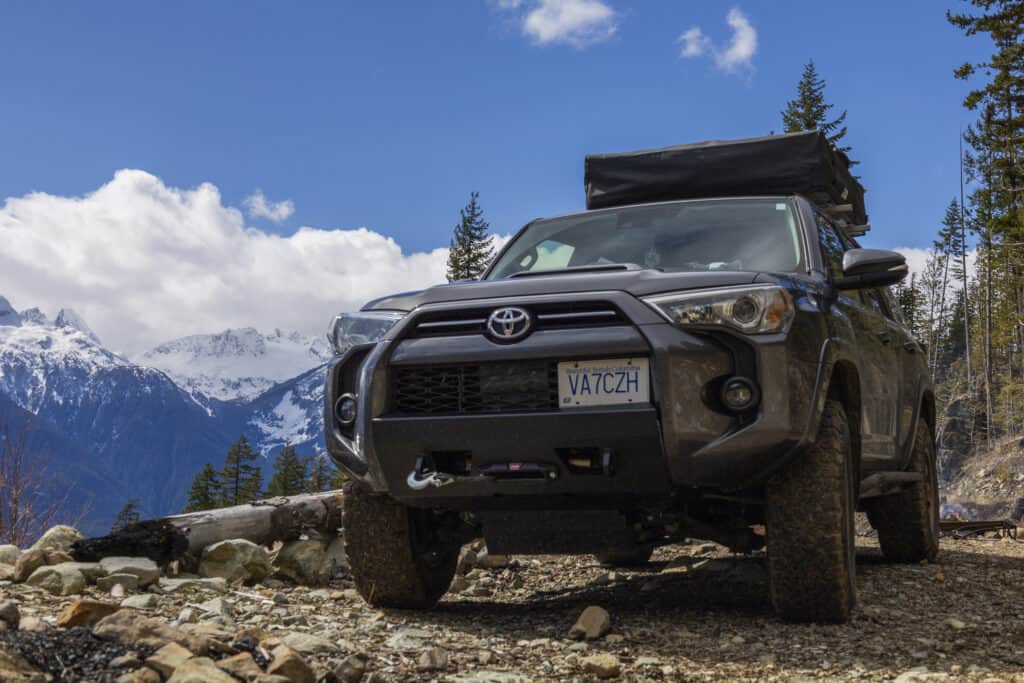
When embarking on an overlanding adventure, having the right gear is just as important as selecting the perfect vehicle. Equipping your adventure vehicle with essential items ensures a safe and enjoyable off-road experience.
All-terrain tires are a must-have for any overlanding expedition. These tires provide better traction and grip on various surfaces, from rocky trails to muddy slopes. Investing in a four-wheel drive vehicle, such as a 4×4, offers a significant advantage when tackling rough terrain. It distributes power evenly to all wheels, allowing you to maintain control and stability during your journey.
Another crucial aspect of your overlanding gear is protection. Adding skid plates to your vehicle helps safeguard its underside from damage caused by rocks, debris, and rough terrain. These plates can be especially beneficial for high-end vehicles and RVs that have important components located underneath.
Comfort is another key factor to consider when preparing for an overlanding adventure. Outfitting your vehicle with a rooftop tent is an excellent addition, as it keeps you elevated and safe from the elements. Rooftop tents often come with a built-in mattress, ensuring a comfortable sleep after a long day on the road. There are numerous rooftop tent options on the market, so be sure to choose one that fits your budget and vehicle size.
When planning a trip to destinations like Baja, it’s essential to carry additional gear that caters to the region’s unique environment. For instance, having sand ladders can be handy for navigating sandy terrain, while an air compressor is useful for adjusting tire pressure accordingly.
In conclusion, outfitting your adventure vehicle with essential gear such as all-terrain tires, four-wheel drive, skid plates, and rooftop tents greatly enhances the off-road experience. With the right equipment, any road trip can turn into an unforgettable overlanding adventure.
Final Thoughts
When choosing the best overlanding vehicle for your budget, it’s important to consider various factors that can affect your off-road experience. Reliability, capability, and affordability should all play a significant role in your decision-making process.
Several options are available in the market to suit different budgets. A Fifth-Gen Ford Ranger (2019-Present) is a top pick for a mid-size pickup truck that offers both reliability and value for money. On the other hand, if you’re looking for a budget-friendly option, you could consider a used 1998 Mitsubishi Montero, which has proven its off-road capabilities over the years.
Keep in mind that high-tech gadgets and modern rigs are not essential for a successful overland journey. You can find affordable and efficient choices that fit your budget, such as vehicles within a few thousand dollars range. Your focus should be on investing in a durable and reliable vehicle that will withstand the challenges of off-road travel.
Ultimately, the best overlanding vehicle for your budget will depend on your individual preferences, needs, and off-road objectives. By researching and comparing various options, you will be better equipped to make an informed decision and embark on your next overland adventure with confidence.
Frequently Asked Questions
What are the top budget-friendly overland vehicles?
Budget-friendly overland vehicles often strike a balance between performance, reliability, and affordability. Some popular choices include the Ford F150, Jeep Cherokee, and Toyota Tacoma. These vehicles are known for their off-road capabilities and durability while still being accessible to a wider range of budgets.
Which used overland vehicles offer the best value?
Purchasing a used overland vehicle can save you money while still providing a reliable and capable adventure platform. Some popular used overland vehicles with a good value for money are the older models of Toyota Land Cruiser, Land Rover Defender, and Nissan Xterra. Keep in mind that maintenance and availability of parts should also be considered when purchasing a used vehicle.
How can I select an overlanding vehicle suitable for my family?
When choosing an overlanding vehicle for a family, prioritize space, comfort, safety, and versatility. Consider vehicles with ample seating and cargo space, such as the Toyota 4Runner, Land Rover Discovery, and Ford Expedition. The ability to easily install child safety seats and additional family-friendly features can also be important factors in making this decision.
What factors should be considered when selecting an overland vehicle within a specific budget?
You should take into account factors such as payload, fuel economy, power output, size, drivability, capability, reliability, and affordability when selecting an overland vehicle within a specific budget. Be prepared to compromise on some aspects depending on your primary goals and requirements.
Why are certain vehicle models preferred for overlanding?
Certain vehicle models are preferred for overlanding due to their off-road capabilities, reliability, and versatility. Models such as the Toyota Land Cruiser, Jeep Wrangler, and Land Rover Defender are popular choices because they are designed to handle challenging off-road conditions while offering useful features and customization options for overland travel.
How do I prioritize features and capabilities when choosing an overland vehicle?
Identify your specific requirements, which may include off-road performance, cargo capacity, fuel economy, and customization options. Once you’ve determined your needs, you can then weigh the importance of each factor and compare various models. Research and test drives are key in determining which vehicles best align with your priorities for overlanding.

